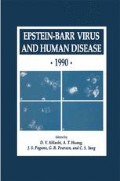Abstract
EBV is etiologicaly associated with endemic Burkitt’s lymphoma and undifferenciated nasopharyngeal carcinoma (NPC), causes infectious mononucleosis and has been implicated in lymphomas arising in immunosuppressed patients and AIDS bearers (1,2). The possibility of controlling the course of these diseases by vaccination has been discussed for a long time (3), especially in the case of NPC which affects up to 2% of the whole male population in southern China and therefore represents a major world cancer problem. Two of the major glycoproteins gp340/gp220, both encoded by the same gene (4) and expressed on the outer surface of virions and infected cells, are capable of eliciting in vitro neutralizing antibodies to EBV (5). A subunit vaccine based on purified gp340 has been successfully used to protect cottontop tamarins against EBV-induced lymphoma (6,7). Nevertheless, the use of recombinant live viruses as vaccine vectors has many advantages for future human trials. These include the ability to produce gp340 in the absence of EBV DNA, posttranslational modification and antigen presentation provided by the host’s own cell, broad spectrum of immune response, induction of long teen immunological memory and low cost. Previous experiments have been carried out using recombinant Vaccinia (8) and Varicella-zoster (9) viruses. Protection against EBV-induced lymphoma was achieved using a Vaccinia recombinant laboratory strain but not a vaccine strain (10). We wish to develop a live vaccine against EBV based on recombinant human Adenovirus (Ad) type 5, producing the EBV envelope glycoprotein gp340/220. Indeed, Ad strains have been used widely in vaccination programs in the U.S. military and have a good safety record (11). Expression cassettes containing an Ad strong promoter followed by the coding region for gp340/220, or by the sequence of a cDNA clone corresponding to the spliced mRNA coding region for gp220, or by these constructions deleted for the region corresponding to the transmembrane and cytoplasmic domains of the protein, were introduced by homologous recombination into the AdS. These viruses where named respectively Adgp340, Adgp220, Adgp340D and Adgp220D.
Access this chapter
Tax calculation will be finalised at checkout
Purchases are for personal use only
Preview
Unable to display preview. Download preview PDF.
References
Epstein M.A. and Achong B.G. (eds) (1979). “The Epstein-Barr Virus”. Berlin, Springer-Verlag.
Epstein M.A. and Achong B.G. (eds) (1986). “The Epstein-Barr Vinas: Recent Advances” London, Heidemann.
Epstein M.A.; J. Natl. Cancer Inst. 56,697 (1976).
Beisel C. etal.J.Virol. 54, 665 (1985).
Thorley-Lawson D.A. et al.; Proc. Natl. Acad. Sci. 77, 5307 (1980).
Epstein M.A. et al.; Nature 318, 387 (1985).
Morgan A.J. et al.;J. Gen Virol. 69, 2093 (1988).
Mackett M. and Arrand J; EMBO J. 4, 3229 (1985).
Lowe S.R.,et al.; Proc. Natl Arad. Sci. 84, 3896 (1987).
Morgan A.J. et al.; J. Med. Virol. 25, 189 (1988).
Chanock R.M.et al.; J. American. Medical. Association.195, 151 (1966).
Tosoni-Pittoni et al.; Biochem. Biophys. Res. Commun. 158, 676 (1989).
De Schryver A. et al.; Int. J. Cancer 13,353 (1974).
Whang Y. et al.; J. Virol. 61, 1796 (1987).
Tanner J. et al.; J. Virol. 62, 4452 (1988).
Author information
Authors and Affiliations
Editor information
Rights and permissions
Copyright information
© 1991 Springer Science+Business Media New York
About this chapter
Cite this chapter
Ragot, T., Tosoni-Pitonni, E., Finerty, S., Morgan, A.J., Perricaudet, M. (1991). Recombinant Adenoviruses Which Express the EBV Major Membrane Antigen GP340/220 Induce Persistent EBV-Neutralizing Antibodies in Rabbits. In: Ablashi, D.V., Huang, A.T., Pagano, J.S., Pearson, G.R., Yang, C.S., Ablashi, K.L. (eds) Epstein-Barr Virus and Human Disease · 1990. Experimental Biology and Medicine, vol 24. Humana Press, Totowa, NJ. https://doi.org/10.1007/978-1-4612-0405-3_36
Download citation
DOI: https://doi.org/10.1007/978-1-4612-0405-3_36
Publisher Name: Humana Press, Totowa, NJ
Print ISBN: 978-1-4612-6747-8
Online ISBN: 978-1-4612-0405-3
eBook Packages: Springer Book Archive

